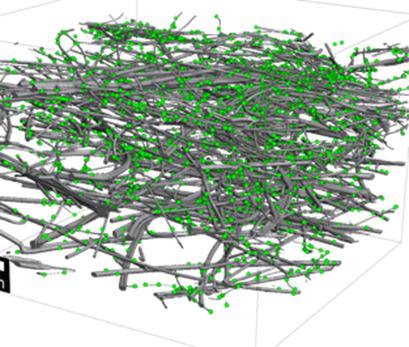当前位置:
X-MOL 学术
›
Chem. Eng. Technol.
›
论文详情
Our official English website, www.x-mol.net, welcomes your
feedback! (Note: you will need to create a separate account there.)
Comparing voxel‐based and mesh‐based CFD models for aerosol deposition on complex fibrous filters
Chemical Engineering & Technology ( IF 1.8 ) Pub Date : 2020-11-03 , DOI: 10.1002/ceat.202000318 Dennis Hoch 1 , Mehdi Azimian 2 , André Baumann 1 , Jens Behringer 1 , Jennifer Niessner 1
Chemical Engineering & Technology ( IF 1.8 ) Pub Date : 2020-11-03 , DOI: 10.1002/ceat.202000318 Dennis Hoch 1 , Mehdi Azimian 2 , André Baumann 1 , Jens Behringer 1 , Jennifer Niessner 1
Affiliation

|
Aerosols represent a health risk since small droplets may enter the respiratory system and cause lung cancer, allergies, or diseases like COVID-19 In this work, an Eulerian-Lagrangian computational fluid dynamics model is used based on a voxel-based (GeoDict) and a mesh-based (StarCCM+) code For evaluating accuracy and computational time of both models, fractional filtration efficiency and pressure drop are compared to an empirical solution for a single fiber and to experimental results for a complex 3D fibrous filter material Simulation results of both methods are in good agreement with empirical and measurement results although the complex geometry of the fibers is captured more accurately by the unstructured mesh using the same resolution Computing times are much faster using the voxel-based code
中文翻译:

比较基于体素和基于网格的 CFD 模型在复杂纤维过滤器上的气溶胶沉积
气溶胶代表健康风险,因为小飞沫可能进入呼吸系统并导致肺癌、过敏或 COVID-19 等疾病在这项工作中,使用基于体素 (GeoDict) 的欧拉-拉格朗日计算流体动力学模型和基于网格的 (StarCCM+) 代码 为了评估两种模型的准确性和计算时间,将部分过滤效率和压降与单纤维的经验解决方案和复杂的 3D 纤维过滤材料的实验结果进行比较 两种方法的模拟结果尽管使用相同分辨率的非结构化网格可以更准确地捕获纤维的复杂几何形状,但与经验和测量结果非常一致 使用基于体素的代码计算时间要快得多
更新日期:2020-11-03
中文翻译:

比较基于体素和基于网格的 CFD 模型在复杂纤维过滤器上的气溶胶沉积
气溶胶代表健康风险,因为小飞沫可能进入呼吸系统并导致肺癌、过敏或 COVID-19 等疾病在这项工作中,使用基于体素 (GeoDict) 的欧拉-拉格朗日计算流体动力学模型和基于网格的 (StarCCM+) 代码 为了评估两种模型的准确性和计算时间,将部分过滤效率和压降与单纤维的经验解决方案和复杂的 3D 纤维过滤材料的实验结果进行比较 两种方法的模拟结果尽管使用相同分辨率的非结构化网格可以更准确地捕获纤维的复杂几何形状,但与经验和测量结果非常一致 使用基于体素的代码计算时间要快得多











































 京公网安备 11010802027423号
京公网安备 11010802027423号